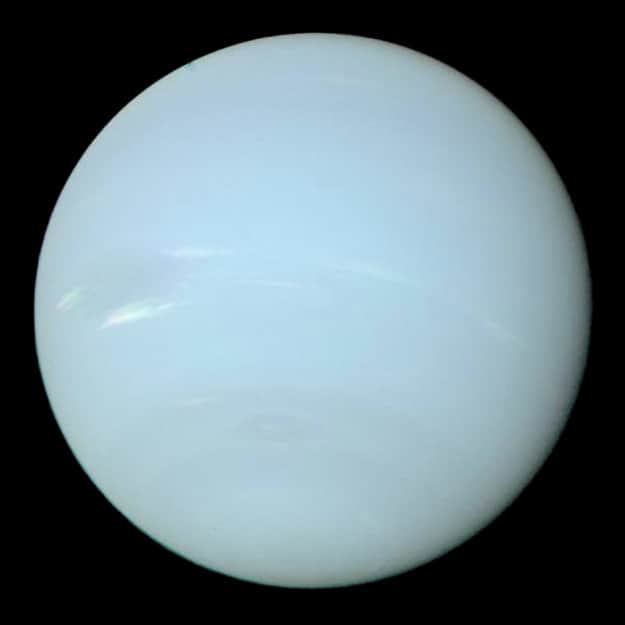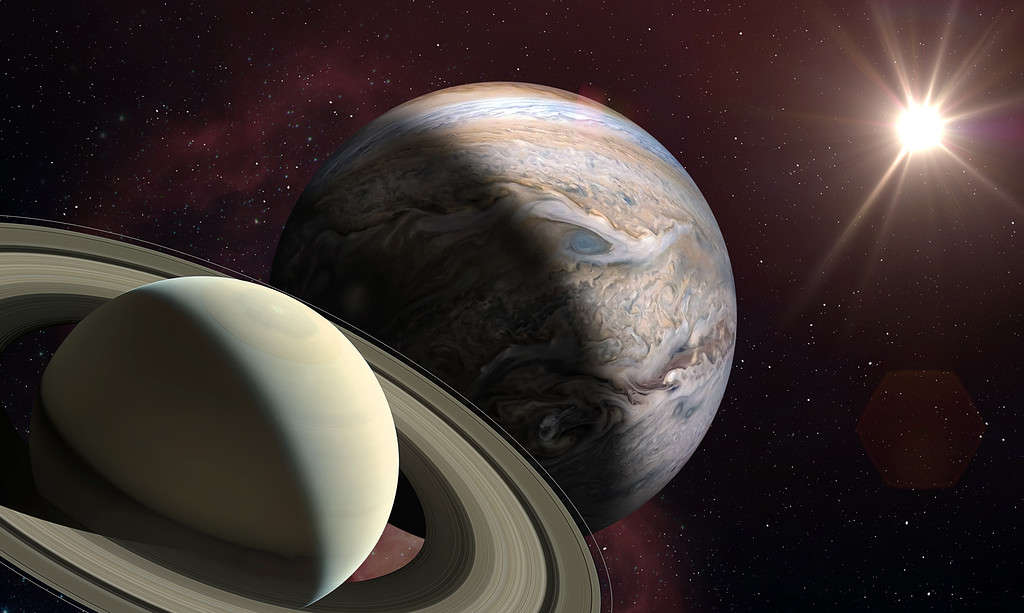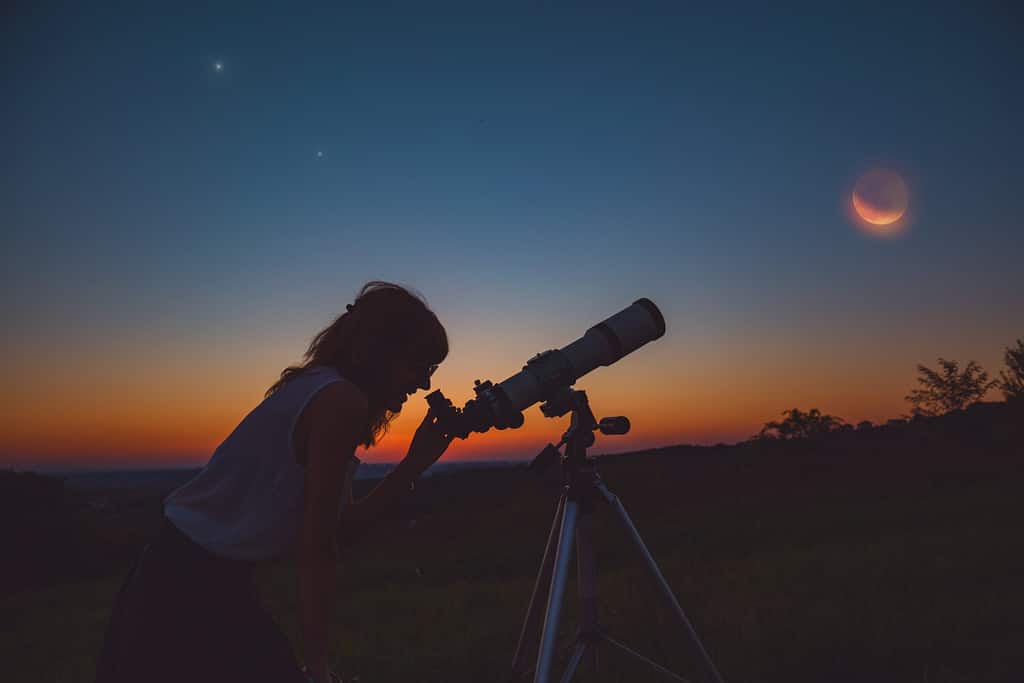What color are the planets of our solar system? Most images you’ve seen of them are color-enhanced to bring out specific details. But what would they look like to the naked eye if you could visit them? It can really take some research to uncover a true-color image. And as it turns out, in 2023 astronomers revealed that when it comes to gorgeous, royal-blue Neptune, we’ve been admiring a deceptively glowed-up version of the real thing.
Neptune: Why So Blue?

This image of Uranus (left) compared to Neptune (right) was based on Voyager 2 flyby photos.
©겸216, CC BY-SA 4.0 , via Wikimedia Commons – License
Neptune and its neighbor nearer to the sun, Uranus, are easy to confuse. Although both have faint rings, neither ring system stands out enough to be pictured in most photos. Both planets have methane in their atmosphere that absorbs red and green light and reflects blue light. However, Neptune’s atmosphere is thicker, so the color is bluer there. Since Voyager 2 sent back photos of Neptune in 1989, typical photos of the planets like the one above picture Uranus in a pale greenish-blue while Neptune is a rich royal blue.
Neptune: True Blue

Oxford University astronomers found that Neptune is closer in color to Uranus.
©Patrick G. J. Irwin, et al., CC BY 4.0 , via Wikimedia Commons – License
In 2023, astronomers at Oxford University reprocessed images of the planets with new data from the Webb Space Telescope. They found that the color of Uranus was fairly accurate, but that Neptune is actually much closer in color to Uranus as well – so much so that the planets are virtually indistinguishable. It’s kind of a letdown, actually. And it can shake our confidence in the images NASA and other agencies have provided. How much of what we see in pictures is real, and how much is art?
Sources of Planetary Photos
So how do we get pictures of the planets anyway, and how and why do astronomers and artists manipulate those images?
Earth-Based Telescopes

Earth-based astrophotography gets the best results at high elevations.
©iStock.com/viennetta
For most of history, the only views of the planets we had were ground-based observations. But one of the great drawbacks of taking pictures of space from Earth is that the atmosphere makes the images more blurry. Light pollution from populated areas can also dim the view of the night sky. The largest and best optical telescopes on Earth, such as the Keck Observatory in Hawaii, are located at high elevations far from cities to minimize these effects.
Orbital Telescopes

James Webb Space Telescope orbits the Earth, taking photos unhindered by atmosphere and pollution.
©NASA/MSFC/David Higginbotham/Emmett Given, Public domain, via Wikimedia Commons – License
The Hubble Space Telescope and the James Webb Space Telescope are observatories that orbit the Earth. Without the haze of the atmosphere and artificial light, they have been able to take pictures of the planets as well as distant stars, nebulae, and galaxies in unprecedented detail.
Interplanetary Spacecraft

It’s easier to see Neptune’s Great Dark Spot with these enhanced, blue-saturated colors.
©iStock.com/3quarks
Humanity’s first successful flyby of another planet was NASA’s Mariner 2 mission to Venus in 1962. Since then, spacefaring nations have launched dozens of probes taking close-up pictures of each of the Solar System’s planets as well as dwarf planets such as Pluto. As for Neptune, however, the only mission to complete a flyby was Voyager 2 in 1989. It discovered five more moons (the planet has 14 in total), four rings, and a “Great Dark Spot” similar to the Great Red Spot on Jupiter.
Why Do Astronomers Alter the Colors of Planetary Photos?

This Webb Space Telescope photo shows Neptune in infrared light, highlighting the rings and moons.
©IMAGE: NASA, ESA, CSA, STScIIMAGE PROCESSING: Joseph DePasquale (STScI), Public domain, via Wikimedia Commons – License
To Learn More About the Planet
You might be surprised to know that most of the cameras on spacecraft and space telescopes don’t take color photos at all, but black and white photos that are tuned to different wavelengths of light. These can reveal important scientific information, such as the minerals in the soil of a rocky planet or asteroid or the elements in its atmosphere. Altering the colors can also reveal fine details in cloud formations or surface features. To get a color image, the light has to pass through filters and be combined to give an approximation of the true color of a planet. This means none of our planetary photos is exactly what a human being would see if they were viewing it with their own eyes.
To Appeal to the Public
Another aspect of the issue, though, is commercial. Space programs are expensive and rely on continuing public support. Releasing dramatic new images of celestial bodies in pleasing colors captures the public’s imagination and their desire for more discoveries. Many of the images taken by NASA and other space agencies are placed in the public domain. Artists download them and filter and enhance them to create the artistic effect they want. Which is all very beautiful, but contributes to the confusion about what the planets really look like.
What Are the True Colors of the Planets?

In true color, Saturn and Jupiter are yellowish beige.
©buradaki/iStock via Getty Images
What about the other planets? Do we have to change our mental pictures of them as well? Not so much. Generally speaking, true-color images of the planets are duller and show less detail than color-enhanced images. Mercury has a greyish-brown tinge like our Moon. Venus is a milky yellowish white. Mars and the Earth don’t look much different than the pictures of them you’ve seen. Jupiter and Saturn are generally shades of pale yellowish beige. The Planetary Society reveals what astronomers believe to be the best natural-color images of the planets.
Why Should We Care?

Color-enhanced images have scientific and artistic uses but can erode confidence in institutions.
©Ground Picture/Shutterstock.com
The true color of Neptune doesn’t affect our lives, but it is part of larger questions that should be of concern. What information is factual, and what is not? Is the image or video I’m seeing real or created by a graphic artist or AI? Can I trust information from institutions, including government agencies? How can I research to find out the facts and the context of the image I am viewing? These questions will have a major impact in the years to come on public trust in institutions and our ability to distinguish factual, reality-based science from fanciful science fiction.
How You Can See the Planets Yourself

A smartphone and a small telescope are sufficient to take photos of each of the planets.
©AstroStar/Shutterstock.com
If you want to see the planets with your own eyes, you don’t have to wait for a billionaire to invite you on a spaceflight. Five planets are visible to the naked eye from Earth: Mercury, Venus, Mars, Jupiter, and Saturn. Two more outer planets are visible through an amateur telescope: Uranus and Neptune. It’s even possible to use a smartphone with a home telescope to take some amazing pictures. Depending on the resolution of your telescope, you’ll be able to capture shots of the rings of Saturn, four of Jupiter’s moons, its Great Red Spot, and even light and dark bands in its atmosphere. As for Neptune, you’ll be able to see a disc of light with a bluish hue. A light bluish hue!
The photo featured at the top of this post is © iStock.com/3quarks
Thank you for reading! Have some feedback for us? Contact the AZ Animals editorial team.






